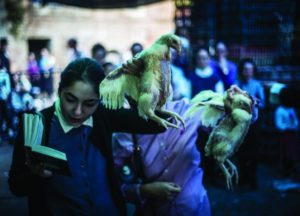By Stacey Ilyse, Kveller
Yom Kippur, the Jewish day of atonement, starts at sundown on Tuesday, Sept. 18.
Traditionally the most somber days on the Jewish calendar, it’s known for fasting and repentance — but its experience of reconciliation also renders is an unparalleled day of joy.
The holiday has some lesser-known associations as well.
1. The word “scapegoat” originates in an ancient Yom Kippur ritual.
Jews historically have been popular scapegoats — blamed for an array of ills not of their creation. But they did originate the term scapegoat. In Leviticus 16:8, read on Yom Kippur, the High Priest is instructed on Yom Kippur to lay his hands upon a goat while confessing the sins of the entire community — and then to throw the animal off a cliff.
2. Another animal ritual, swinging a chicken around one’s head, has sparked controversy.
In 2015, the kapparot ritual, in which a chicken is symbolically invested with a person’s sins and then slaughtered, spurred two lawsuits in the US: one by traditional Jews claiming their right to perform it was being abridged by the government; and another by animal-rights activists.
3. Yom Kippur once was a big matchmaking day.
The Talmud states that both Yom Kippur and Tu b’Av 9the 15th of Av) were the most joyous days of in the Jewish year, when women would wear white gowns and dance in the vineyards chanting, “Young man, lift up your eyes and see what you choose for yourself. Do not set your eyes on beauty, but set your eyes on a good family.”
4. Food and drink are not the only things Jews abstain from on Yom Kippur.
Other traditional restrictions on Yom Kippur include bathing, wearing perfume or lotions, having marital relations and wearing leather shoes.
5. Eating a big meal before the holiday begins will make your fast harder rather than easier.
Traditionally, the meal eaten before beginning the fast is festive, following the Talmudic dictum that it is a mitzvah (commandment) to eat on the eve of Yom Kippur, just as it is a mitzvah not to eat on Yom Kippur itself.
However, eating extra food — particularly in one last-minute feast — does not help to keep you going for 24 hours, says Dr. Tzvi Dwolatzky of Israel’s Rambam Health Care Campus.
He suggests eating small amounts of carbohydrates (bread, potato, rice, pasta), some protein (fish, chicken) and fruit (see the story below for further tips). The festive meal just before the fast begins need not be a big one.
6. On Yom Kippur in 1940, London’s Jews kept calm and carried on.
In the midst of the Battle of Britain, the relentless Nazi bombardment of London that began in September, 1940, the city’s synagogues went on with their Yom Kippur services.
According to JTA, while air raid warnings “twice disturbed” the morning services on Oct. 12, 1940, “most synagogues carried on regardless” and a “large proportion of the men attending services wore uniforms of the various forces.”
On Yom Kippur in Israel in 1973, soldiers were summoned straight from the synagogues to the front as jeeps sped to synagogues to pick them up. Often the soldiers left the synagogues with their talleisim still over their heads. The Yom Kippur War — the surprise attack by Egypt and Syria — had begun.
Many Yom Kippur services continued to conclusion in ill prepared bomb shelters in apartment buildings due to air raid sirens, though no one really knew what was going on.
7. Kol Nidre services are the only night of the entire Jewish calendar when a prayer shawl is worn for evening prayers.
According to the late Rabbi Louis Jacobs, the tallit (prayer shawl) is worn during Kol Nidre as “a token of special reverence for the holy day.”
It is traditional to wear a tallit or a white garment for the entire holiday, with the color white symbolizing both spiritual purity and removal from the vanities of the material world. Many wear the white robe, the kittel.
8. A Virginia rabbi’s pro-civil rights movement sermon on Yom Kippur in 1958 riled up local segregationists and sparked fears of an anti-Semitic backlash.
JTA reported that Virginia’s Defenders of State Sovereignty group demanded that local Jews “move quickly to refute and condemn” Rabbi Emmet Frank of Alexandria’s Temple Beth El for his sermon criticizing the state’s “massive resistance” to school desegregation and said that if he had intended to destroy Christian-Jewish relations, “he could not have been more effective.”
While a “leading member” of the Reform temple reportedly said a “considerable” number of congregants worried Frank’s stand “might result in increased anti-Semitism,” others “sided with the rabbi, holding that he held a spiritual and moral duty to speak out for social justice.”
The congregation stood by Frank, and the Washington Post published an editorial calling him a “courageous clergyman.”

















